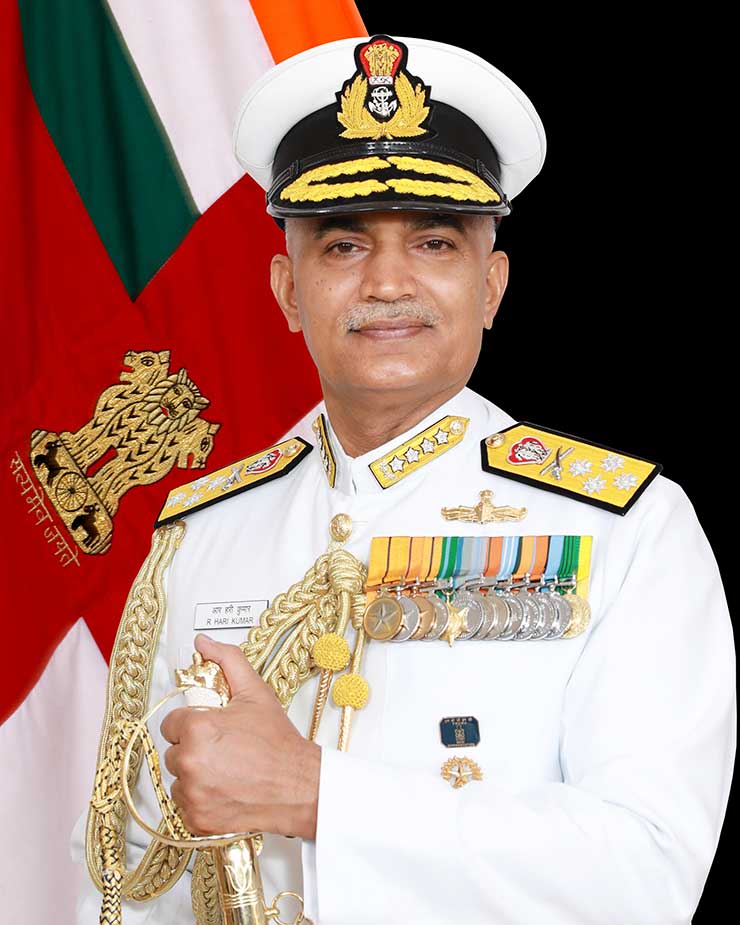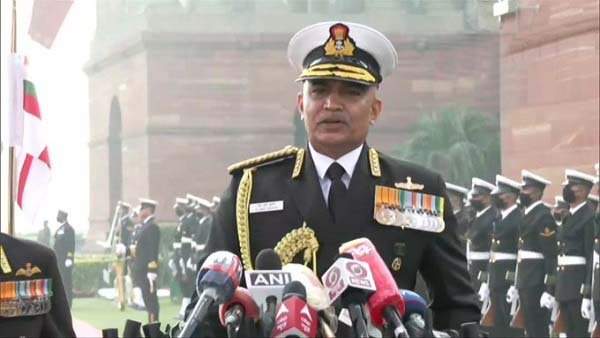 Admiral R. Hari Kumar assumed charge as the 25th Chief of the Naval Staff (CNS) on November 30, 2021 and will be spearheading the process of revising Navy’s 15-year Maritime Capability Perspective Plan, expected to be ready by the first quarter of 2022. The revised plan will be aligned with the 10-year Integrated Capability Development Plan being formulated by the Department of Military Affairs.
Admiral R. Hari Kumar assumed charge as the 25th Chief of the Naval Staff (CNS) on November 30, 2021 and will be spearheading the process of revising Navy’s 15-year Maritime Capability Perspective Plan, expected to be ready by the first quarter of 2022. The revised plan will be aligned with the 10-year Integrated Capability Development Plan being formulated by the Department of Military Affairs.
Admiral Hari Kumar, an alumnus of the National Defence Academy, Khadakwasla was commissioned into the Executive Branch of the Navy on January 1, 1983. During a career spanning nearly 39 years, he has served in a variety of Command, Staff and Instructional appointments. Before taking over as FOC-in-C Western Naval Command, Admiral Kumar was Chief of Integrated Defence Staff to the Chairman, Chiefs of Staff Committee.
In an email interview with Raksha Anirveda to mark the Navy Day 2021, Admiral R. Hari Kumar, the Chief of the Naval Staff, responded holistically and in detail to the questionnaire. Edited excerpts:
RA. The evolving Indo-Pacific space demands that the Indian Navy should be competitive. Do you think the Indian Navy is well prepared to compete in this evolving paradigm?
CNS. The Indian Navy is a pre-eminent maritime power in the IOR and as a professional force evaluates the maritime security environment in the Indo-Pacific on a continuous basis. Our unique geographic location bestows upon us unmatched advantages in the maritime domain as we sit astride some of the world’s most critical Sea Lines of Communication (SLOCs). It places the outer fringes of the IOR and most choke-points almost equidistant from India, thereby facilitating reach, sustenance and mobility of our maritime forces across the region. We are, therefore, well positioned to influence the maritime space, and promote and safeguard our national maritime interests, across the Indo-Pacific. At the same time, India’s vast coastline and maritime zones require significant resources and investments to ensure their security.
The Indian Navy is continuously evolving to meet the emerging challenges to our maritime interests. With well laid out long-term planning, the Indian Navy has been able to keep pace with the developing security situation in the region. Capability and capacity in the form of force readiness and force level planning of the Indian Navy is shaped to meet any challenges in the region. Let me assure your readers that the Indian Navy is one of the formidable maritime forces in the world today and remains well prepared for countering any threat to national security. We are confident that we will be able to deter and if required, defeat any force, well before it can attain a position to threaten our shores.
Further, the Indian Navy has been effectively engaging friendly maritime forces in the Indo-Pacific Region and beyond, through port visits, bilateral interactions, training initiatives, operational exercises and technical support arrangements, in order to establish a cooperative framework that promotes mutual understanding, development of Blue Economy and enhances security and stability in the region. We support a free, open and inclusive Indo-Pacific, wherein no country should be excluded.
RA. There is a thinking over the efficacy of aircraft carriers. There is a big debate too: Whether India should prioritise submarines over an aircraft carrier. What is your view on this if the choice has to be one of these two?

CNS. The maritime domain of the IOR necessitates a strong and robust Indian Navy as a regional maritime power to meet future challenges. The role and responsibility of the Indian Navy is increasing rapidly. This includes the requirement to safeguard our expanding economic interests, as also the responsibilities associated with being a mature and responsible regional maritime power. The Navy’s ability to meet these roles and requirements warrants capability accretion in all dimensions – air, surface, and sub-surface. Thus the Indian Navy requires a balanced force comprising of aircraft carriers, ships and submarines.
RA. What is your choice of aircraft for our carriers? Where does the homegrown Tejas (for Navy) stand?
CNS. Indian Navy is presently operating one carrier, INS Vikramaditya, with IAC 1 being on the anvil. These carriers were envisaged to operate both MiG 29K/ KuB and LCA (Navy).
As LCA (Navy) could not meet Indian Navy’s requirements within the envisaged time frames, the Hon’ble RM had designated LCA (Navy) as a Technology Demonstrator in 2016 and accorded approval for Indian Navy to progress a Case for 57 Multi Role Carrier Borne Fighters (MRCBF) to meet immediate operational requirement. A Case for procurement of a limited number of fighters to meet the immediate requirement of fighters is also being progressed.
In keeping with the Indian Navy’s commitment to ‘AatmaNirbharta’, a predominant portion of our aircraft induction will be realised through Twin Engine Deck Based Fighter (TEDBF). Thrust on TEDBF is being maintained as an indigenous solution to meet future requirement of deck based fighters. Based on project timelines, the TEDBF Project is envisaged as a replacement of the MiG 29K/ KuB and provide an indigenous solution to meet the requirements of INS Vikramaditya, IAC 1 and future aircraft carriers.
RA. What is your view on the theaterisation and integration effort undertaken by the Indian Armed Forces?
CNS. India is a maritime nation with multifarious maritime interests spreading the length and breadth of the region. The appointment of CDS and constitution of DMA has brought in significant synergy at the apex level and led to increased integration and jointmanship amongst the Services. Indian Navy is wholeheartedly committed to this endeavour.
The study on implementation of Maritime Theatre Command is currently in progress with adequate impetus to enhance jointmanship including integration of suitable tri-service assets and resources. The key focus remains on suitable integration of combat power in all domains so as to address all threats and challenges. This would also lead to optimal utilisation of scarce and valuable assets and resources.
RA. What is the status of Project 75 (I)? Do you think the project and procurement process will get realised without delays as many twists keep popping-up?
CNS. As a major step towards realising the Project, the RFP was issued on 20 Jul 2021. The case is being progressed as per the guidelines of the Strategic Partnership Model defined in the Defence Procurement Procedures. The Project is being progressed in close coordination with MoD and all efforts are being put in to ensure that the acquisition process progresses in a timely manner. Any deviations or unforeseen developments that may arise would be proactively addressed to progress the project.









